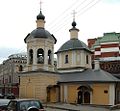Dmitri Wassiljewitsch Uchtomski
Prince Dmitry Vasilyevich Ukhtomsky ( Russian Дмитрий Васильевич Ухтомский * 1719 in Semjonowskoje, today Yaroslavl Oblast ; † October 4 . Jul / 15. October 1774 greg. In Dubki, Ujesd Odojew ) was a Russian architect of the Baroque .
Life
Uchtomski came from a Rurikid family and was a direct descendant of Yuri Dolgorukis . His father Wassili Grigorjewitsch Ukhtomsky was a soldier in semyonovsky regiment and was in 1727 corporal in Nizhny Novgorod - Infantry - Regiment . His mother was Irina Jakowlewna Tschirikowa. In 1731, twelve-year-old Uchtomski was sent to Moscow to attend the mathematics and nautical school. There, however, his talent for architecture showed , so that after graduating from school in 1733 he was accepted into the architectural team of Ivan Fyodorovich Michurin . Michurin taught his students the art of drawing , arithmetic , the theory of the column order and distributed practical exercises. From 1738 to 1770 he was repeatedly active in the Trinity Monastery of Sergiev Posad .
In 1742 Uchtomski moved to Iwan Kusmitsch Korobow , who made him head of his architectural office. For Elisabeth's coronation in 1742 he built numerous triumphal gates and pavilions. In 1744 he was appointed architect of the state with the rank of captain. Uchtomski built the Basmannaja Sloboda . There he built the Nikita Mutschenik Church from 1745 to 1751. In 1748 and 1752 he worked out plans for the construction of fire-destroyed urban areas, the first general plans for Moscow. In 1749/1750 he rebuilt the Sergius von Radonesch Church on Krapiwenski Pereulok. 1749 to 1768 was involved in the construction of the Alexei Petrovich Bestuschew-Ryumin City Palace (not preserved). In 1749 he founded the court school, from which the Moscow Academy of Painting, Sculpture and Architecture emerged. The graduates of the court school were Matwei Fjodorowitsch Kasakow , Iwan Jegorowitsch Starow and Alexander Filippowitsch Kokorinow .
In the 1750s, Uchtomsky directed the remodeling and restoration of the Moscow Kremlin . From 1750 to 1755 he created the Pachomi Church in the Vysoko Petrovsky Monastery. From 1751 to 1759 he completed the construction of the Nikolaus Church on the 2nd Rauschski Pereulok. The Apraxin City Palace was built between 1752 and 1769 . From 1753 to 1757 he converted what was then the triumphal gate near Basmannaja Sloboda on today's garden ring into the magnificent Red Gate , which was demolished in 1927. Today the skyscraper on Ploshchad Krasnye Vorota (Red Gate Square), one of the Seven Sisters, stands there . From 1756 to 1758 he built the Pope Clement Church and the bell tower on Pyatnitskaya Ulitsa . From 1758 to 1761 he built the bell tower of the Chutyn monastery on Volkhov near Novgorod . From 1754 to 1761 in Moscow he carried out the project to build the three- arch -Kuznezki-Most over the Neglinnaja to replace an old one-arch bridge. From 1818 to 1819 the Neglinnaja was passed through an underground canal and the bridge was filled with earth and covered. Many of Ukhtomski's buildings were destroyed by fire.
In 1760, Uchtomski was dismissed from his service through intrigue because of his adversaries, allegedly for embezzlement, and his school was closed in 1764. Although his innocence was determined in court, he left Moscow in 1767 and retired to his country estate Arkhangelskoje-Dubki.
Works
Web links
Individual evidence
- ↑ a b c Мурзин-Гундоров В. В .: Дмитрий Ухтомский . Издательский дом Руденцовых, Moscow 2012, ISBN 978-5-902887-11-9 .
- ↑ Кипарисова А. А .: Д. В. Ухтомский . In: Зодчие Москвы . tape 1 , p. 120-130 ( profilib.net ).
- ↑ LAS Secretary. Bell tower of the Chutyn Monastery, Novgorod
literature
- DI Grabar: DI Uchtomski and Moscow architecture of the mid-18th century. Staatsverlag der Literatur für Bau und Architektur, Moskwa 1954. 415 pp.
- AI Michailow: The architect DW Uchtomski and his school. Staatsverlag der Literatur für Bau und Architektur, Moskwa 1954. 372 pp.
| personal data | |
|---|---|
| SURNAME | Uchtomski, Dmitri Wassiljewitsch |
| ALTERNATIVE NAMES | Ухтомский, Дмитрий Васильевич (Russian) |
| BRIEF DESCRIPTION | Russian architect of the baroque |
| DATE OF BIRTH | 1719 |
| PLACE OF BIRTH | Semyonovskoye, today 's Yaroslavl Oblast |
| DATE OF DEATH | October 15, 1774 |
| Place of death | Dubki, Ujesd Odojew |






